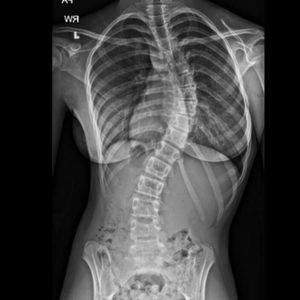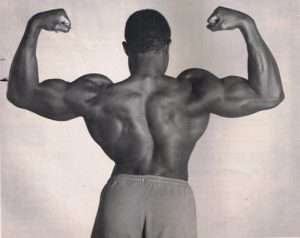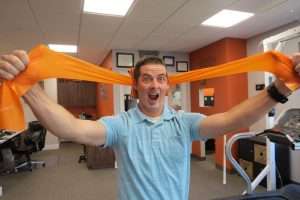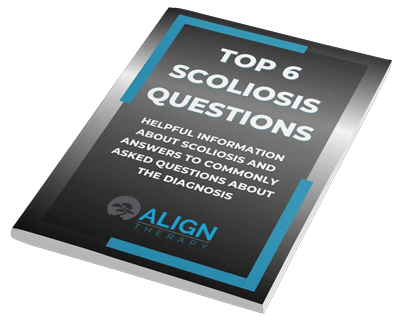One of my greatest joys as a scoliosis therapist is seeing my patients get stronger, reduce their curve, and avoid surgery. Unfortunately, though, this isn’t always the case. With so many variables to what causes progression of the curve, sometimes we are just not successful.
There are many reasons why conservative scoliosis treatment fails. I want to just highlight the top 5.
Top 5 Reasons Scoliosis Treatment Fails
Lack of Consistency
Probably the biggest reason I see for scoliosis treatment failing is when someone does not do the exercises consistently. To be effective, scoliosis specific exercises need to be done at least 5 days a week. This is the minimum.
In Younger Patients
In Adolescent Idiopathic Scoliosis, the reason for this consistency is that they are growing. Their growth plates are active, and as the bone grows the curve does as well. This is because the shape of the bones is changing. Without an external force counteracting that change, such as a brace or muscle contraction, the bone continues to follow the curve.
This is also why consistency is so important with bracing. The external force of the brace pushing the curve back to midline counteracts the growth in the direction of the curve. The result is less bony change, and less curve.
One big problem though with scoliosis specific exercise, unlike the brace, we have to consciously turn on the muscles to get them to do this…at least at first. The idea is to teach the muscles a new movement pattern and have them do this without needing to think as much about it. This takes many repetitions.
The way I describe this with my patients is to consider a sport they love. Let’s say Basketball. How many free throws does it take to consistently make 90% of them? Ask any basketball player and they will tell you it takes hundreds or thousands of shots to build that muscle memory to consistently make the free throw. The same goes for scoliosis exercise.
In Older Patients
For patients with degenerative scoliosis, adult onset, or even pain with scoliosis after they are done growing, the reason for consistency is different. We are still trying to develop movement patterns that don’t need as much mental attention, but this is not to counteract the growth of the bones.
Adult scoliosis patients need consistency to counteract gravity and the pressure that it puts on the spine. This pressure is put on the bones, joints, muscles, etc, and is constant. Unless we are treating an astronaut who spends most of their time on the International Space Station, we have to deal with gravity.
Combine this with the spine degenerating or developing arthritis, and we have a similar scenario to growth in kids…but in the opposite direction. Consistency helps reduce the force that causes these curves to progress and be painful.
Some Curves Just Get Worse

This is my least favorite reason why scoliosis treatment sometimes fails. Some curves are so progressive that no matter what we do, they continue to get worse. The reason why they don’t respond is not totally clear, but sometimes we lose the battle.
Luckily, these types of progressive curves are not very common. It is rare that if someone is consistent with bracing and scoliosis specific exercise, that their curve progresses significantly.
The biggest problem is we do not know who these patients are. It isn’t until their follow up x-rays that we continue to see the progression even with their hard work. It can be difficult to frustrating to see this continued progression, but luckily this does not happen often.
Not Bracing When Appropriate
If I am seeing someone who is a braced, the number one thing I tell them is, “If nothing else, wear the brace!”. Now, I am not saying everything else is ineffective, what I am saying is that bracing, when done correctly, works.
With that said, bracing (in the words of my patients) sucks! There is no argument there. Wearing a brace is uncomfortable, hot, embarrassing, sometimes painful, and inconvenient. But…it has been shown to stop progression of the curve if used as prescribed. That means it is worn AT the right time and FOR the right amount of time.
Right Time?

What does “AT the right time” mean? Bracing is usually considered for curves over 25 degrees where the child still has growth left. Sometimes it is done earlier, but 25 is the current standard. If a curve has progressed to 25 degrees, we know it is a progressive curve and something needs to be done to slow it down.
What does “FOR the right amount of time” mean? This mean wearing it as long as you are asked to. Usually this means more than 14 hours a day. If it is worn much less than that, it is minimally effective. I have many patients who consistently wear the brace for 10 or 11 hours a day, when just a few more hours would make it so much more effective. There are specific types of braces that are worn for 23 hours a day as well.
The amount of time you are in the brace directly correlates with how effective it is. This is because the pressure it is putting on the spine is counteracting the progression that growth is causing in the spine. Growth doesn’t take a break just because you want to take the brace off.
The combination of scoliosis specific exercise and bracing has been shown to be more effective than either one alone. Wearing a brace though is just so much easier. You don’t have to think about it after you put it on, and it is working throughout the day. That is why I say, if nothing else, wear the brace!
Low Quality Scoliosis Specific Exercise
First off, not all conservative methods for treating scoliosis are created equal. There are at least 7 different methods for treating scoliosis with exercise that I know of. Only 2 of those have really been studied significant to know their effectiveness.
 The Schroth Method and the SEAS Approach are the only methods I know of that have significant research to back them. There is still a need for research with all methods of scoliosis treatment, but we do know from current studies that these methods can stop progression of the curve and, in some cases, reduce it. This is not the case with all methods and has definitely not been shown to be the case with general Physical Therapy.
The Schroth Method and the SEAS Approach are the only methods I know of that have significant research to back them. There is still a need for research with all methods of scoliosis treatment, but we do know from current studies that these methods can stop progression of the curve and, in some cases, reduce it. This is not the case with all methods and has definitely not been shown to be the case with general Physical Therapy.
This claim though comes with a caveat! The exercises must be done consistently (as mentioned above with consistency), but they also have to be done well. If someone is consistent in doing them, but is not doing them well or correctly, the effectiveness is significantly reduced.
The challenge is that these exercises are challenging! As a therapist, they are challenging to teach, and as a patient they are challenging to learn. However, once they are learned, they are highly effective.
Doing the exercises correctly requires a lot of attention and concentration. They are not exercises like you would normally find in a home exercise routine. You definitely can’t be watching Netflix or reading while doing them. Ideally, they require your full attention.
The scoliosis patients I see that get the best results are the ones committed to doing the exercises not just consistently, but really well. This comes naturally to some people to be more specific on the exercises, but some really have to work at it.
Discontinuing Bracing Too Early
As discussed before, bracing is used during the growing phase of life. Typically, growth is measured by either a Risser Score, or a Sanders Scale. For the sake of this discussion, we will use the Risser Score because it is most widely used.
Since bracing is used during growth, when someone is done growing, there is no more need for the brace. Sure there are other types of bracing that are done in adults or after growth, but here we are talking about bracing for Adolescent Idiopathic Scoliosis. 
According to the Risser Score, a 0 means the child’s growth plates have not started to close. This means there is a lot of growth left. A Risser 5 on the other hand means growth is mostly done and the growth plates are closed. It is a useful tool to determine growth potential, but it does have its limitations.
If a brace is prescribed, it should be worn until the child is a Risser 5, meaning they are done growing. If bracing is stopped before this, there is a chance they will still have more growth and won’t have the added protection of the brace during that growth.
Boys vs Girls
One of the hardest things about determining growth is the difference between genders. The Risser Score works pretty well for females, but not as well for males. Boys tend to have growth later in life and it is not always predicted with the Risser Score. This is where the Sanders Scale is superior.
There have been quite a few times I have seen braced patients stop bracing because they are told by their doctor that they are done growing when they are at a Risser 4. To me, this is too early to get rid of the brace because the growth potential is still there. Many times, if they have more growth, they have more progression. This could have been avoided by just staying in the brace a little longer!
Conclusion
So, there you have my 5 reasons why conservative scoliosis treatment fails. It is heart breaking to me when I see someone continue to progress even with conservative treatment, and we do all we can to avoid it. Most of the time, though, they fit into one of the 5 scenarios described above.
Remember, when you are trying to control scoliosis with conservative treatment, you must be consistent, wear a brace if necessary, do your exercises well, and not get out of the brace too early to have a great result.
We see amazing results with our scoliosis patients every day, but also see some fail to control their curve. My job is to do everything possible to reduce progression and my patients have the responsibility of doing the same. There are no shortcuts with scoliosis treatment! It takes a lot of hard work.
If you want to learn more about individualized scoliosis specific treatment, please check out our Scoliosis Portal. You can find answers to your questions and learn more about what successful treatment looks like.
Thank you for reading and I hope this was helpful.




